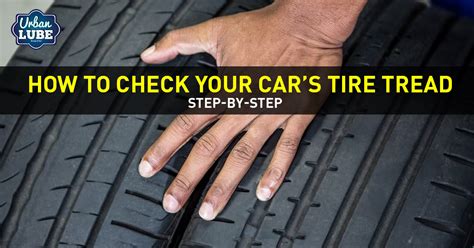How to Check Your Tire Tread: A Comprehensive Guide
Knowing how to check your tire tread is crucial for your safety and the longevity of your tires. Under-inflated or worn tires significantly impact your vehicle's handling, braking distance, and fuel efficiency. This guide will walk you through several methods to accurately assess your tire tread depth, ensuring you're always driving safely.
Why Checking Tire Tread is Important
Driving on tires with insufficient tread depth is incredibly dangerous. Worn tires dramatically reduce traction, especially in wet or icy conditions, increasing your risk of hydroplaning or losing control. This can lead to accidents and potentially serious injuries. Beyond safety, worn tires also:
- Reduce fuel efficiency: More friction between the road and worn tires leads to increased fuel consumption.
- Increase wear and tear on your vehicle: Poor traction forces your car's suspension and other components to work harder, leading to premature wear.
- Shorten the lifespan of your tires: Continuing to drive on severely worn tires will accelerate their deterioration.
Methods for Checking Tire Tread Depth
There are several ways to check your tire tread, ranging from simple visual inspections to using specialized tools.
1. The Penny Test
This is the most common and readily available method:
- Insert a penny: Insert a Lincoln penny, head-down, into the tread groove.
- Check Abraham Lincoln's head: If you can see all of Lincoln's head, your tread depth is less than 2/32 of an inch. This indicates it's time for new tires.
- Repeat across the tire: Perform this test in multiple locations across the tire's tread to ensure a consistent measurement.
2. The Quarter Test
Similar to the penny test, but offers a slightly more precise measurement:
- Insert a quarter: Insert a quarter, head-down, into the tread groove.
- Check Washington's head: If you can see all of Washington's head, your tread depth is below 4/32 of an inch – dangerously low and requiring immediate replacement.
3. Tread Depth Gauge
For a more accurate measurement, a tread depth gauge is recommended. These inexpensive tools provide precise readings in 32nds of an inch.
- Find the deepest groove: Locate the deepest groove in your tire's tread.
- Insert the gauge: Carefully insert the gauge into the groove until it touches the bottom.
- Read the measurement: The gauge will indicate your tread depth. Most tire manufacturers recommend replacing tires when the tread depth reaches 2/32 of an inch.
4. Visual Inspection
While not as precise as the other methods, a visual inspection can help identify significant wear and tear. Look for:
- Uneven wear: Significant uneven wear suggests potential alignment problems that should be addressed by a mechanic.
- Cuts or bulges: These indicate damage and require immediate attention.
- Embedded objects: Remove any embedded objects like stones or nails.
When to Replace Your Tires
As a general rule, replace your tires when the tread depth reaches 2/32 of an inch. However, consider replacing them sooner if you notice any significant wear, damage, or unevenness. Consult your tire's sidewall for the recommended tread wear indicators. These are small bars embedded in the tread that appear when the tread depth reaches the replacement threshold.
Maintaining Your Tires for Optimal Performance
Regular tire maintenance significantly extends their life and enhances safety. Remember to:
- Check tire pressure regularly: Maintain the recommended tire pressure as indicated on the sticker located inside your driver's side doorjamb or in your owner's manual.
- Rotate your tires: Rotating your tires helps ensure even wear and tear. Consult your owner's manual for the recommended rotation schedule.
- Perform regular alignments: Proper wheel alignment prevents uneven tire wear.
By following these steps, you can ensure your tires are always in optimal condition, contributing to a safer and more efficient driving experience. Remember, your tires are your connection to the road – keep them in top shape!
